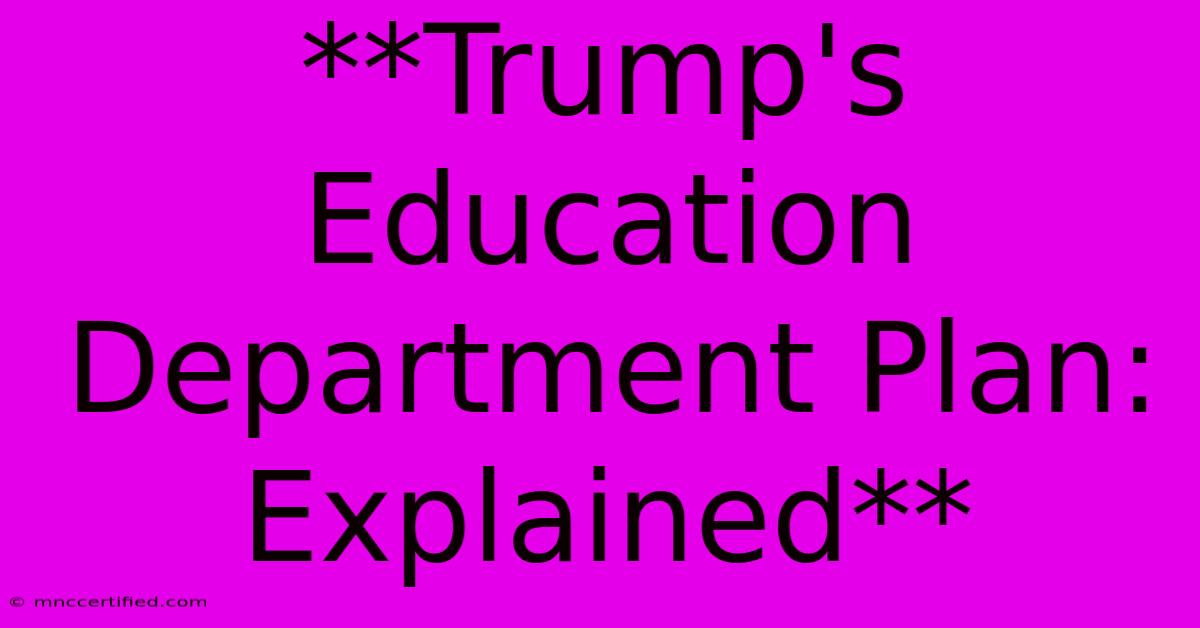**Trump's Education Department Plan: Explained**

Table of Contents
Trump's Education Department Plan: Explained
During his presidency, Donald Trump implemented several changes to the United States Department of Education. While his administration championed school choice and parental rights, his policies were often met with controversy, with some praising his focus on school accountability and others criticizing his cuts to funding and regulations.
This article will delve into the key elements of Trump's education department plan, examining its impact on students, teachers, and the overall educational landscape.
Focus on School Choice and Parental Rights
Trump's education agenda was largely driven by his belief in school choice and empowering parents in their children's education. He advocated for expanding access to charter schools and voucher programs, arguing that these options gave parents more control over their children's education and provided alternatives to struggling public schools.
Key Policies:
- Expansion of school choice programs: Trump supported the expansion of voucher programs, allowing parents to use public funds to pay for private school tuition. He also pushed for greater flexibility in charter school funding and regulations.
- Focus on parental involvement: Trump emphasized parental rights in education, advocating for greater transparency and accountability in schools. He promoted policies that gave parents more say in their children's education, including the ability to opt-out of standardized testing.
- Promoting school safety: Trump signed the Fix NICS Act, aimed at strengthening background checks for gun purchases and preventing individuals with mental health issues from acquiring firearms. This initiative focused on enhancing school safety and addressing concerns about gun violence in educational settings.
Education Reform and Accountability
Trump's administration sought to implement sweeping reforms in the education system, emphasizing accountability and performance-based measures. They argued that these reforms would improve educational outcomes and ensure that all students were receiving a quality education.
Key Policies:
- Rethinking Common Core Standards: While not outright abolishing the Common Core State Standards, Trump advocated for increased local control over education and encouraged states to revise or replace the Common Core.
- Emphasis on standardized testing: The administration emphasized rigorous standardized testing as a measure of school and student performance. This policy was controversial, with critics arguing that it created an overemphasis on test scores and led to a "teaching to the test" approach.
- Focus on vocational training: The administration sought to realign education programs with the needs of the workforce, promoting vocational training and apprenticeships to address skill gaps in the labor market.
Criticism and Controversies
Trump's education policies were met with mixed reactions, with critics raising concerns about funding cuts, the impact on vulnerable populations, and the potential for increased segregation in schools.
Key Criticisms:
- Funding cuts: Critics argued that Trump's administration underfunded the Department of Education and made significant cuts to federal education programs. These cuts, they argued, would disproportionately affect low-income schools and students.
- Increased segregation: Some critics expressed concerns that Trump's emphasis on school choice would lead to increased segregation in schools, as students from different socioeconomic backgrounds would be likely to attend different schools.
- Erosion of teacher protections: Trump's administration proposed changes to teacher tenure laws, which critics argued would weaken teacher protections and make it easier to fire teachers without due process.
Conclusion
Trump's education department plan aimed to empower parents and schools with greater control over education, focusing on school choice, accountability, and performance-based measures. While his policies generated significant debate, they undoubtedly left a lasting impact on the educational landscape. By analyzing the key elements of his plan and the surrounding controversies, we can gain a deeper understanding of the ongoing debates surrounding educational reform in the United States.

Thank you for visiting our website wich cover about **Trump's Education Department Plan: Explained**. We hope the information provided has been useful to you. Feel free to contact us if you have any questions or need further assistance. See you next time and dont miss to bookmark.
Featured Posts
-
In The Groove Doves Fiona Apple Mitski
Nov 13, 2024
-
Overtime Drama Pistons Beat Heat
Nov 13, 2024
-
How To Sell Roofs Through Insurance
Nov 13, 2024
-
I M A Celebrity 2024 Campmates Jungle Fears
Nov 13, 2024
-
Insurance For Party Rental Business
Nov 13, 2024